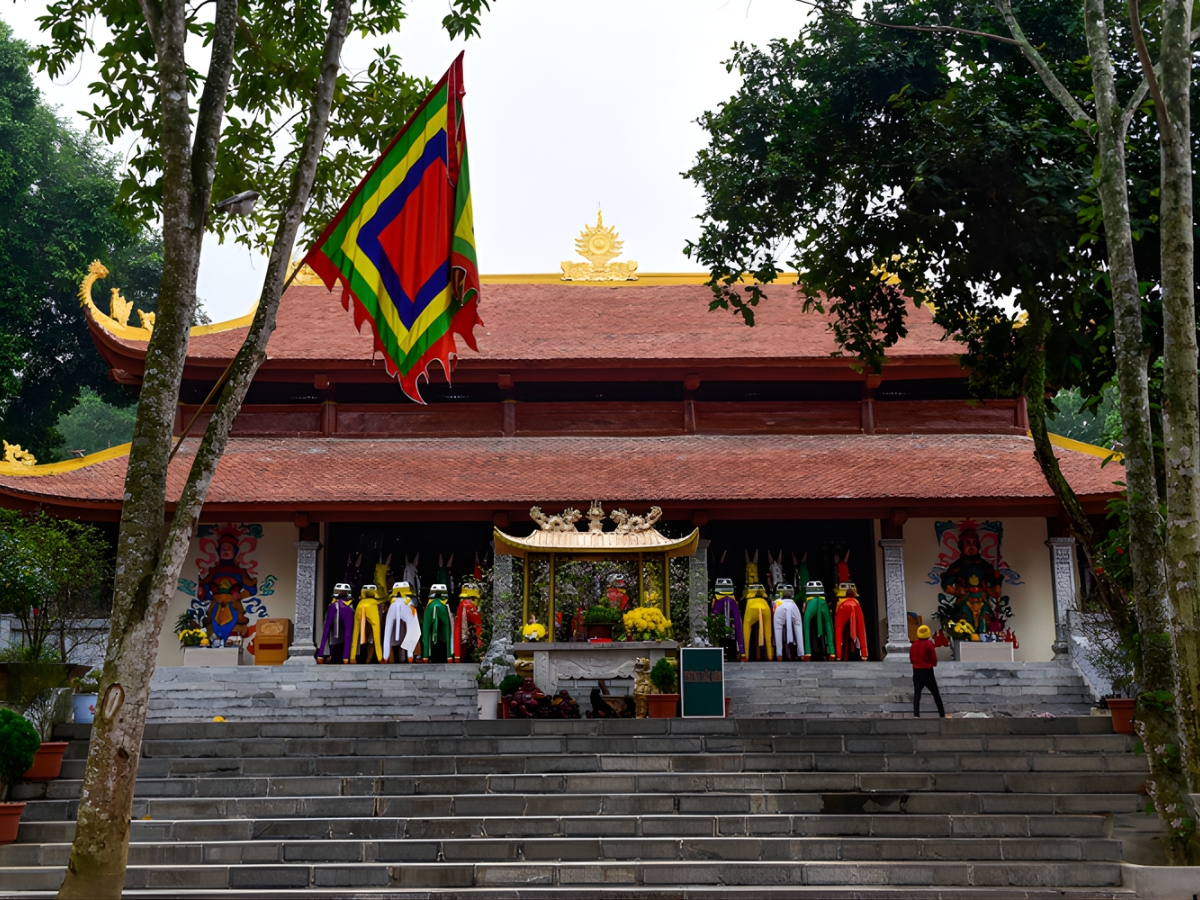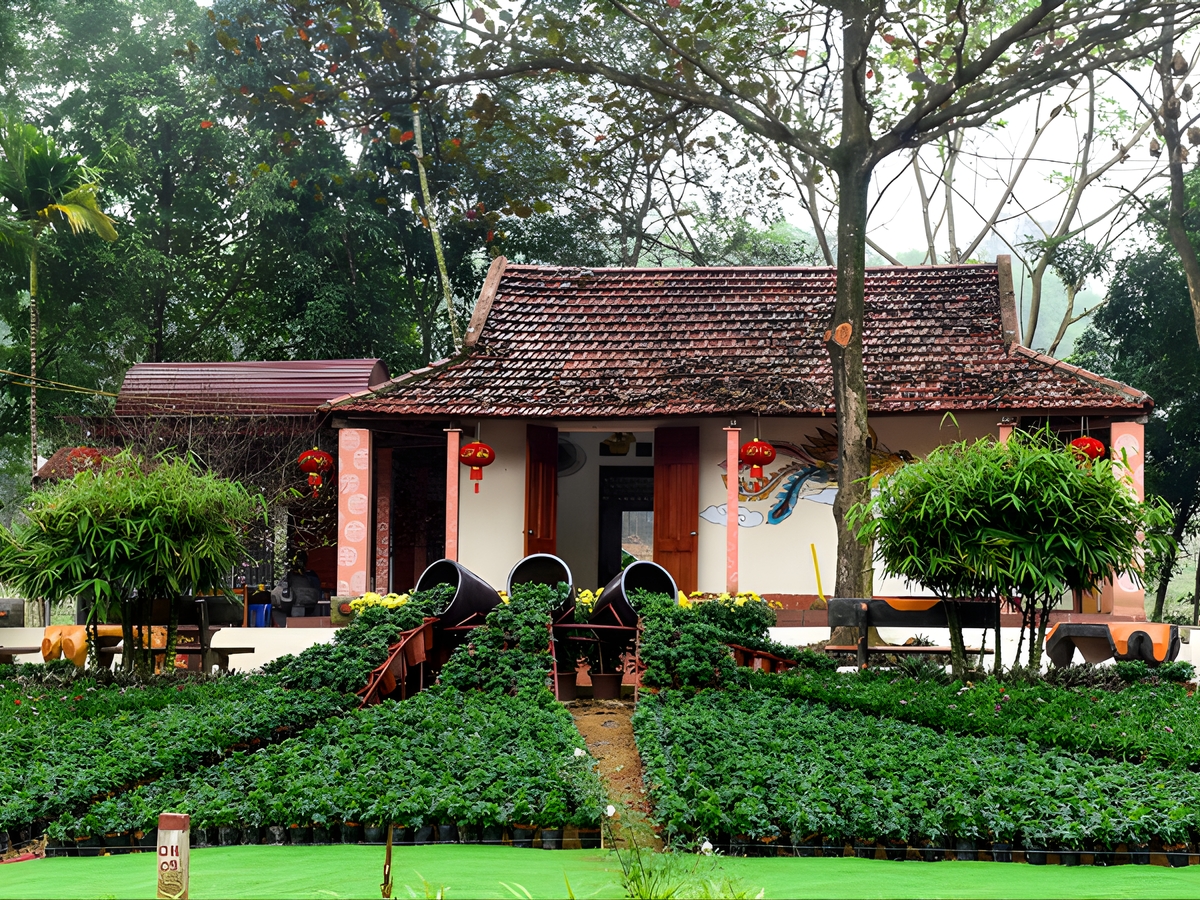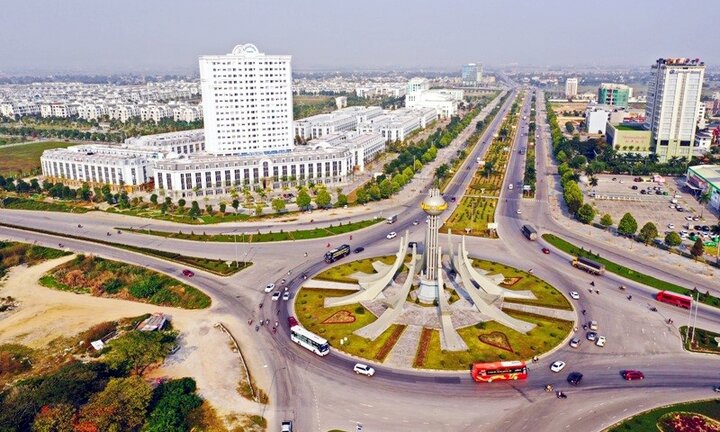1. Discover Phu Na - A sacred destination in Thanh Hoa land
1.1. Geographical location and religious culture at Phu Na
Phu Na , also known as Na Son Dong Phu, is located in Xuan Du commune, Thanh Hoa province. Situated at the foot of the majestic Nui Nua mountain, which once marked the uprising of female general Trieu Thi Trinh against the invading Dong Ngo army, Phu Na possesses a beauty that is both sacred and poetic. The landscape here converges mountains, forests, streams, and waterfalls, creating a picturesque natural scene in the midland region of Thanh Hoa, making anyone who visits feel the tranquility and the converging spiritual energy of heaven and earth.
Phu Na is a place of worship for many deities, notably Ba Trieu, Mau Thuong Ngan, and Thanh Mau Lieu Hanh. Locals and visitors often come here to offer incense for peace, luck, and career success, while also enjoying the scenery, asking for holy water, and purchasing local specialties such as fresh tea, bitter leaves, or glutinous rice wine.

Phu Na is a place of worship for many saints in Vietnamese spiritual culture. (Source: Collected)
1.2. History of Phu Na's Formation
According to the remaining traces at the Nghi Thien Ha Mother Temple, Phu Na was built in 1909 during the Nguyen Dynasty, with architecture bearing a strong traditional style. Although it worships many deities, the focal point of the temple remains the worship of the Mother Goddess. Legend has it that when Saint Mother Lieu Hanh arrived in the Xuan Du region, the beliefs of worshipping Tan Vien Son Thanh, Mother Au Co, and Chua Thuong Ngan already existed here. Over time, these beliefs merged, reflecting the cultural exchange between the Vietnamese and Muong people, forming the unique worship system at Phu Na .
Upon arriving at Phu Na , visitors feel as if they are reliving the heroic spirit of Ba Trieu, the majestic female general in the nation's golden history. It was in this sacred place that she raised her troops for rebellion, strategizing with her generals and fostering the indomitable spirit to resist foreign invaders. Amidst the solemn atmosphere of Nui Nua mountain and the wisps of incense smoke, the image of Ba Trieu appears strong and proud, leaving each person with deep reverence and pride.
With its profound historical, cultural, and spiritual values, on January 28, 1993, Phu Na was recognized as a National Cultural and Scenic Relic. This is not only a source of pride for the people of the Thanh region but also a vivid testament to the enduring vitality of Vietnamese folk beliefs through the centuries.
2. Architectural Beauty and Sacred Space of Phu Na
2.1. Famous Spiritual Temple and Shrine System
The space of Phu Na is a place where nature and belief harmonize, gathering many sacred temples and shrines worshipping both celestial and human deities. Among them, the worship of the Mother Goddess is the most prominent, a characteristic cultural aspect deeply connected to the spiritual life of the Vietnamese people. The temples dedicated to Mau Thuong Ngan, Ba Trieu, and Princess Lieu Hanh form the soul of the complex, giving Phu Na a beauty that is both solemn and sacred, expressing the deep reverence of the Thanh people for their national spiritual roots.
2.2. Natural Landscape and Ecological Experience Area
The natural landscape around Phu Na possesses pristine, tranquil beauty, where mountains, forests, streams, and sky blend like a picturesque landscape painting. Visitors can stroll along the small paths around the temple, listening to the rustling wind and the echoing birdsong amidst the vast wilderness. At the foot of Nui Nua mountain, many popular check-in spots include stone bridges, wells, or moss-covered stone steps leading up to the main temple area. Each step is a peaceful experience, helping visitors shed their worries and find inner balance.

Green natural scenery at Phu Na Temple. (Source: Collected)
2.3. Artifacts, legends, and historical imprints
Inside Phu Na, many precious historical vestiges and cultural values are still preserved, clearly reflecting the rich tradition of this sacred land. Each artifact, each structure is a testament to a period of ups and downs in history, associated with the legend of Ba Trieu and the rebellious spirit of the people of the Thanh region. Therefore, Phu Na is not only a spiritual destination but also a symbol of patriotism, national pride, and the enduring vitality of Vietnamese culture.
3. Experience festivals and spiritual activities at Phu Na
Each year, the Phu Na festival is held twice, attracting a large number of local people and visitors from all over for pilgrimage and worship. The first festival takes place from January to the end of February of the lunar calendar, while the second festival is held from the first to the fifteenth day of the eighth lunar month in Xuan Du commune, Thanh Hoa province. This is an occasion for people to commemorate the merits of the Holy Mother, pray for national peace, abundant harvests, and peaceful lives.
Like many other traditional festivals, the Phu Na festival consists of two parts: the ceremony and the festivities. The ceremony is solemn with worship rituals deeply rooted in Mother worship beliefs, expressing the people's reverence for saints and deities. The festivities are more lively and joyful with unique cultural, artistic, and folk game activities, creating an atmosphere of excitement, unity, and community bonding.
Visiting Phu Na, tourists can not only immerse themselves in the sacred festival atmosphere but also have the opportunity to admire the charming natural scenery of the Nua mountain region. The system of temples and shrines nestled amidst the lush green valley offers a sense of peace and closeness. During the exploration journey, visitors can stop to worship at the temples of Saint Mother Lieu Hanh, Mother Thuong Ngan, and Ba Trieu, while capturing meaningful moments amidst the majestic mountains and forests.

Festive and bustling atmosphere at Phu Na at the beginning of spring. (Source: Dai Doan Ket Newspaper)
The Phu Na festival has long been an indispensable part of the cultural and spiritual life of the people of Thanh Hoa in particular and the Muong community in general. Every Tet holiday, tens of thousands of tourists flock here to offer incense, pray for prosperity, pray for love, and enjoy the vibrant atmosphere of the festival season in the sacred mountain region of Thanh Hoa.
4. Some useful experiences and notes when visiting Phu Na
Suggested attire and necessary items:
When visiting Phu Na, tourists should choose polite, neat attire suitable for the spiritual space. As the temple area is located at the foot of Nua mountain with many stairs and steep paths, sports shoes or flat sandals are suitable choices for convenient movement. Tourists should also bring umbrellas, hats, drinking water, and some light snacks to ensure their health during the pilgrimage and exploration journey. For photography enthusiasts, a small camera or a phone with good shooting quality will help capture memorable moments in this sacred land.
Notes on customs and culture when participating in the festival and visiting Phu Na:
Phu Na is a sacred place of worship, so visitors need to maintain a respectful attitude and comply with the regulations of the relic site. When offering incense, dress neatly, perform rituals seriously, and do not speak loudly or laugh in the worship area. Avoid touching worship items, statues of deities, or ancient artifacts without permission. During the festival days, the number of people is very large, so visitors should move gently, maintain order, and avoid jostling or pushing to ensure a solemn and safe atmosphere for everyone.
Tips for photography and capturing beautiful moments at Phu Na:
The space of Phu Na offers many impressive photo opportunities, from the moss-covered Tam Quan gate, the stone steps leading to the main hall, to the view of the overlapping mountains and forests surrounding it. Visitors should choose early morning or late afternoon when the sunlight is gentle and mist still lingers on the mountaintops to get the most sparkling photos. During the festival season, scenes of palanquin processions, lion dances, or streams of pilgrims in traditional costumes are wonderful opportunities to capture vivid and emotional images of Thanh Hoa's culture.
Suggestions for combining visits to nearby destinations:
After visiting Phu Na, tourists can combine visits to other nổi bật destinations in Thanh Hoa such as Xuan Pha temple, Ham Rong bridge, and Sam Son beach square. In addition, the Huyen Tich Am Tien spiritual tourist area at Nua mountain is currently under construction and promises to become an attractive destination in the near future. Combining these itineraries will provide tourists with a comprehensive experience, allowing them to learn about history and culture while enjoying the natural beauty and unique spiritual life of Thanh Hoa.

The spiritual relic site of Huyen Tich Am Tien promises to become an attractive destination in the future. (Source: Collected)
The journey to Phu Na is not just a pilgrimage to the Holy Mother, but also an opportunity for visitors to find peace amidst nature and nurture faith in good values. Amidst the sacred space at the foot of Nui Nua mountain, each incense stick offered is like sending a wish for a new year of peace, happiness, and fulfillment. Therefore, try visiting Phu Na Thanh Hoa once to fully appreciate the cultural beauty, beliefs, and age-old spirit of the people of Thanh Hoa.







